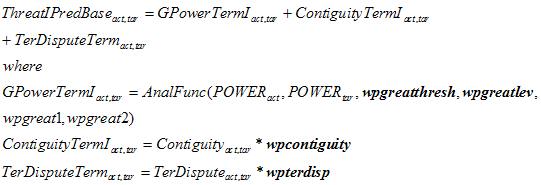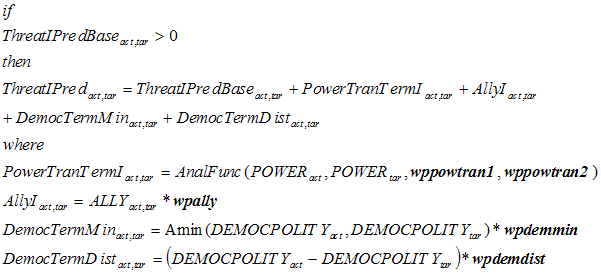International Futures Help System
IP Equations: Initial Threat Terms
Threat in a dyad is calculated using either empirically based initial conditions (ThreatIData) or predicted initial conditions (ThreatIPred). Empirical values come from the Militarized International Dispute (MIDs) database. Mark Crescenzi provided empirical initial conditions from that database using a technique for representing "memory" of past events (more distant events are less memorable) that he and Andrew Enterline pioneered (Crescenzi and Enterline 2001). A significant problem was that the initial conditions for dyads involving Cold War adversaries were no longer credible after the end of the Cold War. Moreover, the MIDs database used for the estimations extended only to 1992. Therefore the IFs project relied on expert judgment to reset some of those value: essentially, conflict for important Cold-War dyads like the U.S.-Russia was put at zero after 1992 and the Crescennzi-Enterline technique was used through 2002 in order to erode the earlier Cold-War memory in the creation of initial conditions.
Predicted initial conditions use a formulation that relies on some of the strongest empirical predictors of interstate conflict. The first three are constant or switch factors: great power status of the dyad members, contiguity, and existence of territorial dispute (all of which substantially increase the threat of conflict). Each term merits some comment:
- Great power status is often (for instance, in the Correlates of War project) determined subjectively. Because IFs needs to forecast that status, not just to apply it without change over time, the model needed an objective definition of it. In general it may be safe to argue that all states with more than about 5% of total systemic power are great powers, and no states with less than 2% of systemic power are great powers. Yet even those cut-offs could be debated. Because of the range of uncertainty, IFs uses a variable representation of the status, designating any state below the lower level (carried by the parameter wpgreatthesh) as a non-great power, and any state above the upper level (wpgreatlev) as a great power, conferring partial status in between for selected computations (like that of systemic power concentration). The internal IFs variable GPowerTermI carries the resulting calculation of increased threat of conflict from great power status in the dyad, where wpgreat1 determines the contribution of full great power status and wpgreat2 determines the contribution of partial great power status.
- Paul Diehl generously provided contiguity data for IFs (CONTIGUITY) and the parameter wpcontiguity translates the impact of contiguity into increased threat of conflict (ContiguityTerm).
- The work of Paul Huth (1996) was tapped for territorial disputes (TerDispute). The parameter wpterdisp translates the existence of a dispute into increased threat of conflict (TerDisputeTerm).

If any of these three factors are positive, the dyad members are "politically relevant" to each other, thereby increasing their sensitivity to other factors. In politically relevant dyads, IFs adds three other factors to the calculation of initial threat levels: a power transition term, an alliance term, and a two-term democracy representation. Again, each factor needs elaboration:
- The initial power transition term (PowerTranTermI) begins with a computation of the ratio of power within the dyad (PowerRatio). If that ratio exceeds a threshold level (wppowtran1) then the increased threat of conflict in the power transition term is set equal to the difference between the power ratio and the threshold power transition level, multiplied by an impact parameter (wppowtran2).
- The alliance term (AllyI) is simply the exogenously-specified existence (1) or absence (0) an alliance times a parameter (wpally) than translates alliance into conflict reduction.
- Senese has found that the impact of democracy on the threat of conflict depends on both the lesser level of democracy in the states of the dyad and the difference between their levels. The lesser or minimum level is multiplied by a parameter (wpdemmin) to determine the minimum democracy term (DemocTermMin) and the distance in democracy is multiplied by a second term (wpdemdist) to determine the contribution of the distance term to changed threat of conflict (DemocTermDist).

 International Futures at the Pardee Center
International Futures at the Pardee Center